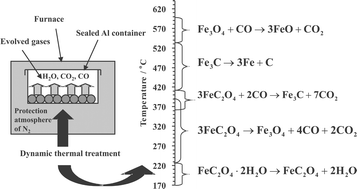Thermal behaviour of iron(ii) oxalate dihydrate in the atmosphere of its conversion gases
Abstract
Using a device for

* Corresponding authors
a
Centre for Nanomaterial Research, Palacky University, Svobody 26, Czech Republic
E-mail:
martin.hermanek@upol.cz
Tel: +420 585634947
b
Department of Physical Chemistry, Palacky University, Svobody 26, Czech Republic
E-mail:
zboril@prfnw.upol.cz
Tel: +420 585634947
c
Department of Experimental Physics, Palacky University, Svobody 26, Czech Republic
E-mail:
maslan@prfnw.upol.cz, machala@optnw.upol.cz
Tel: +420 585634951
d
Institute of Physics of Materials AS CR, Žižkova 22, Czech Republic
E-mail:
schneew@ipm.cz
Tel: +420 532290434
Using a device for

 Please wait while we load your content...
Something went wrong. Try again?
Please wait while we load your content...
Something went wrong. Try again?
M. Hermanek, R. Zboril, M. Mashlan, L. Machala and O. Schneeweiss, J. Mater. Chem., 2006, 16, 1273 DOI: 10.1039/B514565A
To request permission to reproduce material from this article, please go to the Copyright Clearance Center request page.
If you are an author contributing to an RSC publication, you do not need to request permission provided correct acknowledgement is given.
If you are the author of this article, you do not need to request permission to reproduce figures and diagrams provided correct acknowledgement is given. If you want to reproduce the whole article in a third-party publication (excluding your thesis/dissertation for which permission is not required) please go to the Copyright Clearance Center request page.
Read more about how to correctly acknowledge RSC content.
 Fetching data from CrossRef.
Fetching data from CrossRef.
This may take some time to load.
Loading related content
